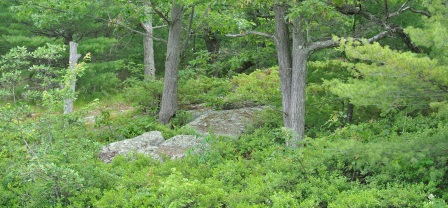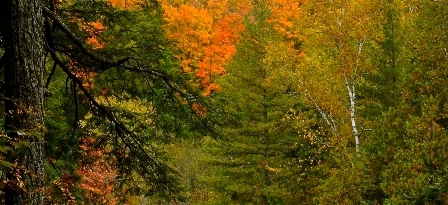Monthly Archives: August 2013
Muskoka’s Biodiversity – Part 3: Managing for the conservation of biodiversity

The previous two articles in this series have talked about the importance of biodiversity and how Muskoka’s biodiversity has changed and will continue to change. What can we, as a community, do to manage these changes so that biodiversity and ecosystem function are maintained?
Both on land and in the water, the Muskoka River watershed of today is a stage in a journey as ecosystems shift and change, sometimes, but not always, because of human activity. It follows that, if maintenance of watershed health is to be our goal, we have to understand, anticipate, and (where possible) manage the changes that will surely come in the future, even if climate change and biodiversity loss were not upon us.
We face a significant challenge, but the role of biodiversity in promoting ecosystem resilience offers us a clear path forward.
To put it simply, biodiversity confers resilience, and resilient ecosystems respond better to environmental changes, continuing to function well and continuing to provide the goods and services on which we depend.
With change of many types happening, and knowing that we will not be able to control all change, the Muskoka community should adopt management approaches that conserve biodiversity throughout our region.
This “management for conservation of biodiversity” is simply good stewardship – acting in ways that favour long-term sustainability of ecosystem function. It is a task for land owners, other seasonal and permanent residents, visitors, provincial ministries, and local and regional governments. All members of our community will benefit from such stewardship; the challenge is that with climate change and growing pressures of development, the task of conserving biodiversity becomes more difficult.
For example, if our goal is to conserve the biodiversity of our forests, then the following set of principles adapted from the paper Forest Resilience, Biodiversity, and Climate Change (Thompson et al., 2009) provide a basis for preserving forest biodiversity through enhancing forest resilience:
- Maintain genetic diversity in forests by not selecting only certain trees for harvesting based on site, growth rate, or form, and replant with trees of different genotypes.
- Ensure managed forests remains as structurally complex as natural forests, using natural forests as a model.
- Maintain connectivity across forest landscapes by reducing fragmentation, recovering lost habitat types, and expanding protected area networks.
- Maintain functional diversity (and redundancy) by ensuring that forests do not get replaced with a monoculture.
- Reduce non-natural competition by controlling invasive species and using a variety of native species in reforestation projects.
- When planting trees, use local stock that is adapted to the climate while also planning for future climatic changes by planting species that will thrive in expected future conditions.
- Maintain biodiversity at all scales (stand, landscape, bioregional) and of all elements (genetic, species, community) by protecting isolated populations of organisms, populations at the limits of their distribution, and populations in areas that are naturally buffered from extreme climate change. These populations are the most likely to form core populations as conditions change.
- Encourage local governments to implement natural areas strategies that identify representative protected areas; and corridors and connections between them.
Learn more about biodiversity in Muskoka in the MWC publication Muskoka’s Biodiversity: Understanding our Past to Protect our Future, available at www.muskokawatershed.org.
Past articles are available in this blog under the Watershed Notes Articles category or under Past Articles in the Resources section.
Muskoka’s Biodiversity – Part 2: A changing environment

Last week’s article talked about biodiversity in Muskoka and why it is important for our environment and economy. Is Muskoka’s biodiversity getting better or worse?
A historical review of changes in Muskoka’s environment revealed the impact of humans, particularly in the changes that have occurred in the past two centuries – the devastation caused by waves of early logging in removing the pine, hemlock and mixed hardwood forests; extensive land clearing for agriculture; development of transportation systems and early settlements.
Changes in practice, and reductions in economic importance, of both the logging industry and agriculture, along with development of the tourism industry, have resulted in a dramatic turn-around in our environment and our biodiversity that has continued to the present day.
Decline in Biodiversity
The risks to biodiversity in Muskoka are best understood when placed in a context of global trends. The scientific community is agreed that, globally, the world is currently experiencing a significant decline in overall biodiversity.
While scientists do not agree on the exact percent of species loss, it is generally agreed that between 20% and 50% of all species on the planet risk extinction by 2100. In Muskoka-Parry Sound, there are currently 35 species identified provincially as Species at Risk.
This decline, referred to as the Holocene mass extinction event, is occurring for many reasons. Globally, human destruction and modification of natural habitat are reducing the capacity of the environment to support other species, leading to reductions in species’ population sizes and to local extinction. Direct exploitation of animals and plants also contribute.
Our development of industrial-scale agriculture and our rapid conversion of land into cities are also displacing many species, fragmenting populations and lowering genetic diversity. Human caused climate change and pollution are further exacerbating the difficulties faced by other species.
In Muskoka, similar processes, working on a smaller scale, are impacting our local biodiversity. All of these processes lead to lower overall biodiversity and lost resilience in ecosystems.
While there is an overall trend towards lower biodiversity, the pace of that decline varies from place to place and from system to system, and the true extent of the decline is still somewhat uncertain although it is clearly substantial.
In Muskoka, the generally high quality of our natural environment has buffered us from the high level of species extinction seen elsewhere in the world. However, even in Muskoka we cannot become complacent about biodiversity loss.
Many of the factors that contribute to biodiversity loss are at work here in Muskoka – climate change, development, pollution, invasive species – maintaining our high quality environment is central to continued prosperity in our recreation and tourism economy.
Direct economic use of biodiversity in Muskoka through forestry and agriculture has declined to only a fraction of its importance in the period from 1800-1950. In contrast, recreation and tourism industries continue to expand, with an increased rate of expansion predicted in the coming decades, along with population expansion. How will these changes impact Muskoka’s biodiversity and what will be the costs to our environment and economy?
We who live in Muskoka, and depend on our environment for both the quality of our lives and the strength of our economy, have much to gain by recognizing the risks we face, and treating them as a challenge to build the healthy environment we will need in our future.
Learn more about Muskoka’s changing biodiversity in the MWC publication Muskoka’s Biodiversity: Understanding our Past to Protect our Future, available at www.muskokawatershed.org. Next week in Muskoka’s Biodiversity – Part 3, we will talk about management approaches that can be taken by the Muskoka community to conserve biodiversity throughout our region.
Past articles are available in this blog under the Watershed Notes Articles category or under Past Articles in the Resources section.
Muskoka’s Biodiversity – Part 1: Why is it important?
 Biological diversity – or biodiversity – is a term used to describe the variety of life on Earth. It refers to the wide variety of ecosystems and living organisms: animals, plants, their habitats and their genes.
Biological diversity – or biodiversity – is a term used to describe the variety of life on Earth. It refers to the wide variety of ecosystems and living organisms: animals, plants, their habitats and their genes.
It is an essential part of our environment, enabling our ecosystems to maintain productive soils, clean water, and fresh air. Biodiversity also confers ecosystem resilience, which can help our environment recover from future shocks and changes.
Levels of Biodiversity
Biodiversity can be understood on three interacting levels: ecosystem, species and genetic diversity. In Muskoka, there are several ecosystem types including forests, wetlands, open lands and waterways; this variety of ecosystems is ecosystem diversity.
Species diversity includes all the plants, animals and microorganisms that inhabit each of these ecosystems, as well as link organisms that move between different ecosystems, such as migratory birds, mammals, reptiles, and microorganisms. These organisms, together, carry the broad array of genes that provide for genetic diversity.
Maintaining healthy levels of overall biodiversity is essential if ecosystem goods and services are to be sustained. Ecosystem goods are items such as timber, furs, fish and ‘wild’ foodstuffs that we extract from the environment, while ecosystem services include the provision of high water quality, clean air and healthy soils, and the processing of our domestic, agricultural and industrial wastes.
Resilience versus Redundancy
An ecosystem is said to be disturbed when events occur that impact it negatively – a forest fire, a flood, a clear-cut, or the arrival of a new pathogen are all examples of disturbance.
Biodiversity provides various ‘self-repair’ mechanisms that achieve resilience, allowing an ecosystem to cope with disturbances or change without materially altering its capacity to provide its goods and services.
Genetic diversity can provide resilience through selection, adaptation, and evolution, enabling species to respond to long-term change in environmental conditions (individual trees that survive the Emerald Ash Borer and therefore can continue the species is an example). This resilience can be overpowered by changes which are too extensive, or too rapid.
Species diversity can provide an ecosystem with another type of resilience, because one species can substitute for another in fulfilling specific environmental functions as conditions change in ways that favour some but not other species. Ecosystems with lower species diversity have less redundancy and are less resilient because of it.
The relationships between biodiversity and the resilience of ecosystems in the face of various types of environmental change provide a solid basis for the claim that the conservation of biodiversity is important for continued ecosystem function including its provision of environmental goods and services on which our lives and our economy depend.
Learn more about the importance of biodiversity in Muskoka in the MWC publication Muskoka’s Biodiversity: Understanding our Past to Protect our Future, available at www.muskokawatershed.org. Next week in Muskoka’s Biodiversity – Part 2, we will touch on how Muskoka’s biodiversity is changing and what that might mean for Muskoka’s environment and economy.
Past articles are available in this blog under the Watershed Notes Articles category or under Past Articles in the Resources section.
